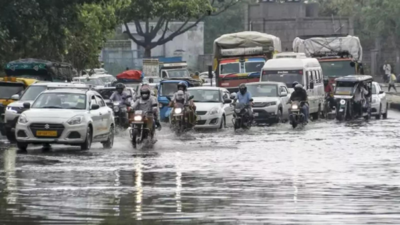NEW DELHI: Monthly average rainfall over the country as a whole in Sept is most likely to be ‘above normal’, at more than 109% of the long-period average, the IMD said on Sunday. It also warned of possible heavy rainfall events during the month in Uttarakhand, north Rajasthan, south Haryana, Delhi and parts of north Chhattisgarh, saying the extreme events may trigger landslides, mudslides, flash floods and urban flooding.Geographically, most parts of the country are likely to receive ‘normal’ to ‘above normal’ rainfall in Sept, while some parts of the northeast and east India, many areas of extreme south peninsular India and some parts of northernmost India are likely to receive ‘below normal’ rainfall, the IMD said.Underlining a trend of increasing rainfall in Sept since the 1980s, IMD chief Mrutyunjay Mohapatra said it was advisable for the authorities to remain alert and take all precautionary measures to avoid potential risks.He attributed increasing rainfall in the month to shifting of the monsoon withdrawal date from Sept 1 to Sept 17 over the years, saying the interaction of western disturbances with the monsoon system during the transition month leads to higher-than-normal rainfall. Heaviest August rain since 1996, says IMD The IMD’s data for Aug shows that though the average rainfall during the month was merely 5% above the normal, northwest India and the South Peninsula reported 34% and 31% above the normal rainfall, respectively. This led to cloudbursts, landslides and flash floods in Uttarakhand, Himachal Pradesh and J&K; the flooding of farms in Punjab that damaged agricultural crops; and many episodes of urban flooding in cities, including in Delhi.IMD’s data shows that rainfall over northwest India in Aug was the highest for the month since 1996 and the 13th highest since 1901, whereas it was the third highest for south peninsular India since 2001 and the eighth highest since 1901.Mohapatra said though there was no increasing trend of cloudbursts in the country, the data at least showed an increasing trend of ‘mini-cloudbursts’ that led to landslides and other disasters, specifically in the hilly region of the country. A cloudburst is a short-lived extreme weather event in which heavy rainfall occurs over very small areas (20-30 sq km) at a very fast rate (100mm per hour). In a mini-cloudburst, rainfall occurs at the rate of 50mm per hour. In India, cloudbursts occur during the monsoon season, normally over orographically dominant regions like the Himalayan region, northeastern states and Western Ghats.Citing the example of heavy rains in Chennai on Saturday, Mohapatra said cloudbursts or mini-cloudbursts are not limited to hilly regions.




